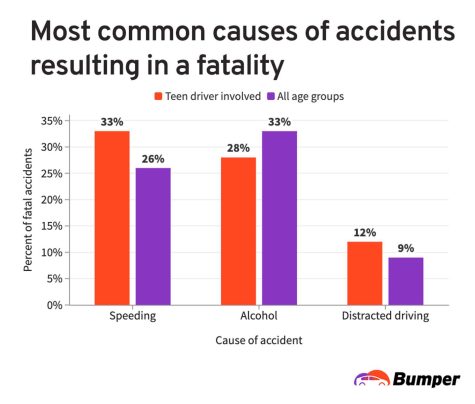Keeping Teen Drivers Safe
February 22, 2022
Motor vehicle crashes are the second leading cause of death for U.S. teens and Missouri is one of the top ten states with the most car crash fatalities for teens (National Highway Traffic Safety Administration).
How big is the problem?
For teenage drivers, the risk of being involved in a car accident among 16-19-year-olds is higher than among any other age group. In 2019 there were 2,734 teenagers (ages 13-19) who died in the United States from crash injuries – the leading cause of death in that age group.
Who is most at risk?
Males: In 2019, the motor vehicle death rate for male drivers aged 16–19 was over two times higher than the death rate for female drivers of the same age.
Teens driving with a teen or young adult passengers: The presence of teen or young adult passengers increases the crash risk of unsupervised teen drivers. This risk increases with each additional teen or a young adult passenger.
Newly licensed teens: Crash risk is particularly high during the first months of licensure. Data from the 2016–2017 National Household Travel Survey indicates that the crash rate per mile driven is about 1.5 times as high.
What is the cause of this increase?
Nighttime and weekend driving: In 2019, 40% of motor vehicle crash deaths among teens aged 13–19 occurred between 9 pm and 6 am, and 52% occurred on Friday, Saturday, or Sunday.
Not using seatbelts: In 2019, 43.1% of U.S. high school students did not always wear a seat belt when riding in a car driven by someone else. Among teen drivers and passengers 16–19 years of age who died in car crashes in 2019, almost half were unrestrained at the time of the crash.
Speeding: In 2019, 31% of male drivers aged 15–20 years and 17% of female drivers aged 15–20 years who were involved in fatal crashes were speeding.
Alcohol and Drug Use: In 2019, 15% of drivers aged 15–20 involved in fatal motor vehicle crashes had a BAC of 0.08% or higher – a level that is illegal for adults aged 21 or older in all U.S. states (Missouri has a BAC limit of .08%).
Could the problem stem before they even get behind the wheel?
The Missouri Department of Revenue does not require new drivers to complete a drivers ed program, unlike 32 other states that require it. The minimum age to obtain a learner’s permit is 15, which you must have for 6 months before taking the driver’s exam. However, you don’t need 50 hours of supervised driving instruction, unlike 27 other states. With recent increases in traffic fatalities, especially among teen drivers, the Missouri Department of Revenue needs to implement significant changes to licensing distribution or the state’s overall traffic deaths will continue to increase.
How to keep teen drivers safe?
Living in a state without a law for driver’s ed classes does not exempt us from being sufficiently prepared to drive. It is well worth the time involved for you and your parents to take your own steps to prepare you for driving alone. Parents should ride along with their teen, watching closely and making suggestions on how they could improve, driving at different times of the day and in different conditions (weather, traffic, etc.) and eliminating distractions, it is recommended to have zero to one passenger the first six months of having a license. Practicing these factors will make you more confident in your driving skills, keep you alert to other drivers on the road, and help you learn traffic laws, road signs, and other important driving information.


